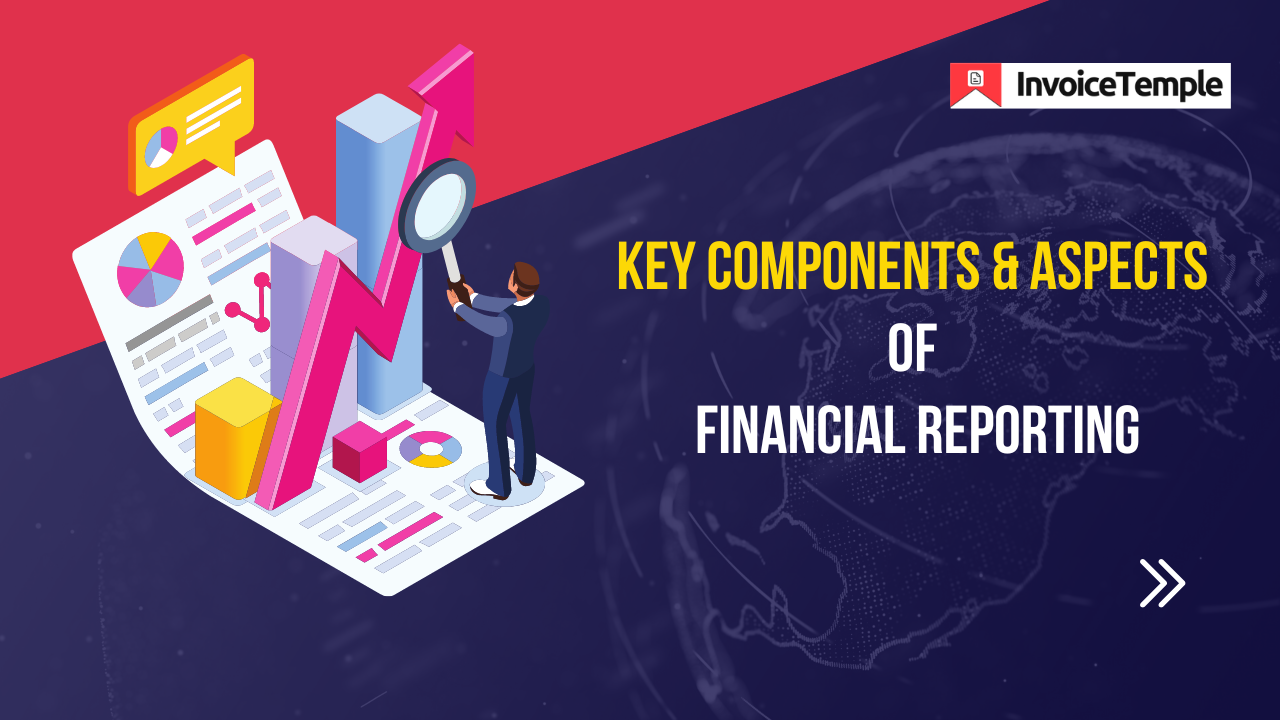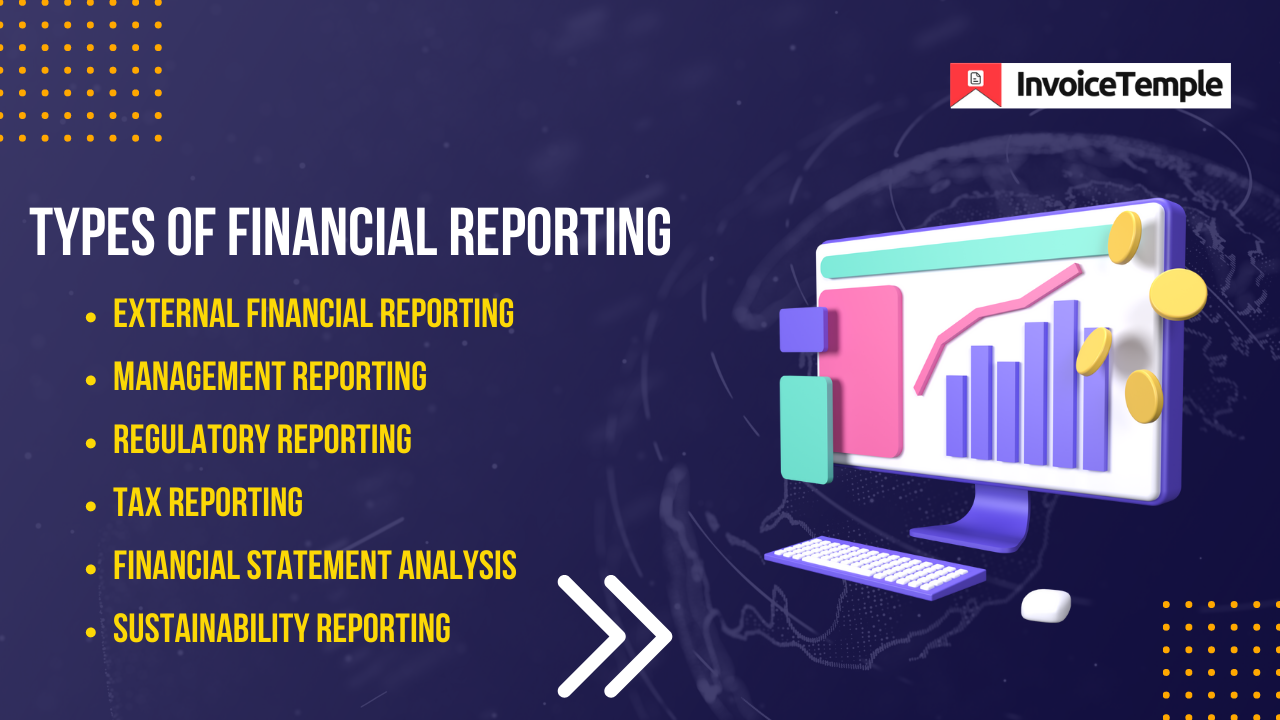Know More About Financial Reporting: Types, Benefits, Objectives, and Limitations

Financial reporting refers to the process of providing financial information to external parties, such as investors, creditors, regulators, and other stakeholders.
It involves the preparation and presentation of financial statements, along with accompanying disclosures and notes, that accurately depict the financial performance, position, and cash flows of an organization.
Here are key components and aspects of financial reporting:

- Financial Statements: Financial statements are the primary output of financial reporting. They include:
- Income Statement (or Statement of Comprehensive Income): It shows the revenues, expenses, gains, and losses over a specific period, resulting in net income or loss.
- Balance Sheet (or Statement of Financial Position): It presents the organization's assets, liabilities, and shareholders' equity at a specific point in time, reflecting its financial position.
- Statement of Cash Flows: It summarizes the cash inflows and outflows from operating, investing, and financing activities, providing insights into cash management.
- Statement of Changes in Equity (or Statement of Shareholders' Equity): It presents the changes in shareholders' equity, including contributions, distributions, and retained earnings.
- Generally Accepted Accounting Principles (GAAP): Financial reporting follows a set of accounting principles and standards known as GAAP. These principles provide guidelines for recognizing, measuring, presenting, and disclosing financial information to ensure consistency, comparability, and transparency.
- International Financial Reporting Standards (IFRS): In many countries, including over 100 jurisdictions, financial reporting software is based on IFRS, which is a global set of accounting standards issued by the International Accounting Standards Board (IASB). IFRS aims to enhance the comparability and transparency of financial statements across different countries and industries.
- Accrual Basis Accounting: Financial reporting is typically based on accrual accounting, which recognizes revenues and expenses when they are earned or incurred, regardless of when the cash is received or paid. This provides a more accurate depiction of financial performance and financial position over a specific period.
- Disclosure and Footnotes: Financial reporting requires the inclusion of disclosures and footnotes accompanying the financial statements. These provide additional context, explanations, and details about specific accounting policies, estimates, risks, and significant transactions that are relevant for understanding the financial statements.
- External Auditing: Financial statements are often subject to external audit by independent auditors. Auditors examine the financial statements, assess their compliance with accounting standards, and provide an opinion on their fairness and reliability. Auditing adds credibility and assurance to the financial reporting process.
- Regulatory Compliance: Financial reporting is subject to various regulatory requirements and oversight, such as filing financial statements with regulatory bodies, ensuring compliance with securities regulations, and meeting reporting deadlines.
- Management Discussion and Analysis (MD&A): In addition to the financial statements, financial reporting may include an MD&A section. This is a narrative report where management provides insights, analysis, and explanations of the financial results, significant events, risks, and future prospects of the organization.
Financial reporting plays a critical role in facilitating informed decision-making by external users of financial information. It helps stakeholders assess the financial health, performance, and prospects of an organization, enabling them to make investment decisions, provide credit, evaluate risk, and monitor compliance with regulations.
TYPES OF FINANCIAL REPORTING
There are several types of financial reporting that serve different purposes and cater to specific stakeholders. Here are the key types of financial reporting:

External Financial Reporting:
>>This is the most common type of financial reporting and involves the preparation and presentation of financial statements for external users.
>>It includes the income statement, balance sheet, statement of cash flows, and statement of changes in equity.
>>External financial reporting follows accounting principles and standards, such as GAAP or IFRS, and is typically audited by external auditors.
Management Reporting:
>>Management reporting focuses on providing financial information and analysis to internal stakeholders, primarily management and executives within the organization.
>>It includes various reports, dashboards, and key performance indicators (KPIs) tailored to meet the specific needs of management.
>>Management reports help in monitoring performance, making strategic decisions, and evaluating the financial health of the organization.
Regulatory Reporting:
>>Regulatory reporting refers to the financial information that organizations are required to submit to regulatory authorities, such as government agencies, central banks, or industry-specific regulators.
>>Regulatory reports ensure compliance with specific laws, regulations, and reporting requirements.
>>Examples include reports related to taxation, securities regulations, banking regulations, and environmental regulations.
Tax Reporting:
>>Tax reporting involves the preparation and submission of financial information to comply with tax laws and regulations.
>>It includes the calculation and reporting of taxable income, deductions, credits, and other tax-related information necessary for filing tax returns.
>>Tax reporting ensures accurate and timely compliance with tax obligations.
Financial Statement Analysis:
>>Financial statement analysis is not a specific type of reporting but rather a process that involves analyzing and interpreting the information presented in financial statements.
>>It aims to assess the financial performance, profitability, liquidity, solvency, and overall financial health of an organization.
>>Financial statement analysis helps investors, creditors, and other stakeholders make informed decisions and evaluate the organization's performance relative to industry peers.
Sustainability Reporting:
>>Sustainability reporting, also known as corporate social responsibility (CSR) reporting or environmental, social, and governance (ESG) reporting, focuses on disclosing information related to an organization's environmental and social impact, corporate governance practices, and sustainability initiatives.
>>It provides stakeholders with insights into the organization's commitment to environmental stewardship, social responsibility, and ethical practices.
These are some of the key types of financial reporting. The specific types and formats of financial reporting may vary depending on factors such as the nature of the organization, industry regulations, and stakeholder requirements.
It is essential for organizations to understand their reporting obligations and tailor their financial reporting processes to meet the needs of their stakeholders effectively.
OBJECTIVES OF FINANCIAL REPORTING
The objectives of financial reporting are to provide relevant, reliable, and transparent financial information about an organization's financial performance, position, and cash flows. These objectives are aimed at serving the information needs of various stakeholders. Here are the main objectives of financial reporting:
Provide Information for Decision-Making:
>>Financial reporting aims to provide information that helps stakeholders make informed decisions.
>>Investors, creditors, and other users rely on financial statements to evaluate the financial health, profitability, and risks associated with investing or lending to an organization.
>>Timely and accurate financial information assists in assessing the viability and potential returns of investment opportunities.
Assess Financial Performance:
>>Financial reporting enables stakeholders to assess an organization's financial performance over a specific period.
>>By analyzing financial statements, users can evaluate the organization's revenue, expenses, profitability, and overall financial results.
>>This information assists in measuring the organization's success in achieving its financial objectives and supports performance comparisons with industry peers.
Evaluate Financial Position:
>>Financial reporting software provides information about an organization's financial position at a specific point in time.
>>The balance sheet presents the organization's assets, liabilities, and shareholders' equity, enabling stakeholders to assess its liquidity, solvency, and capital structure.
>>Understanding the financial position assists in evaluating the organization's ability to meet short-term obligations and support long-term growth.
Assess Cash Flows:
>>Financial reporting includes the statement of cash flows, which presents the organization's cash inflows and outflows from operating, investing, and financing activities.
>>Users can evaluate the organization's ability to generate and manage cash, assess its cash flow patterns, and determine its liquidity and cash flow risks.
>>This information is crucial for understanding the organization's cash flow management and its ability to fund operations and investments.
Facilitate Accountability and Transparency:
>>Financial reporting promotes accountability and transparency by providing an accurate and complete representation of an organization's financial activities.
>>It helps stakeholders assess the stewardship and governance of the organization's resources.
>>Transparent financial reporting builds trust, enhances credibility, and encourages ethical behavior.
Support Compliance with Legal and Regulatory Requirements:
>>Financial reporting ensures compliance with accounting principles, standards, and legal requirements.
>>By adhering to established reporting frameworks, organizations provide standardized and comparable financial information.
>>Compliance with regulatory reporting requirements helps ensure the organization meets legal obligations and provides accurate and reliable information to regulatory authorities.
Facilitate Economic Decision-Making:
>>Financial reporting plays a broader role in supporting economic decision-making at the macro level.
>>Aggregated financial information from various organizations provides insights into the overall economic health, trends, and performance of an industry, sector, or country.
>>This information assists policymakers, analysts, and researchers in formulating economic policies, conducting market analysis, and monitoring economic indicators.
Overall, the objectives of financial reporting aim to provide relevant, reliable, and transparent information to stakeholders, enabling them to make informed decisions, assess financial performance and position, promote accountability, and support economic decision-making.
LIMITATIONS OF FINANCIAL REPORTING
While financial reporting provides valuable information to stakeholders, it is important to recognize its limitations. Here are some limitations of financial reporting:
Historical Information:
>>Financial reporting primarily provides historical information about an organization's past performance and financial position.
>>It may not capture real-time or future-oriented data that stakeholders need for decision-making.
>>Users must complement financial reporting with other sources of information to assess current and future trends.
Simplification and Aggregation:
>>Financial reporting involves the simplification and aggregation of complex financial transactions and events into summarized information.
>>This simplification may result in the loss of detailed information and nuances, making it challenging to fully understand the underlying business dynamics.
Subjectivity and Estimates:
>>Financial reporting requires the use of estimates, assumptions, and judgments to account for uncertain events or transactions.
>>These subjective elements introduce a level of uncertainty and potential bias in the reported financial information.
>>Users should be aware that financial statements may include management's discretion and rely on accounting policies that may differ across organizations.
Limited Non-Financial Information:
>>Financial reporting primarily focuses on financial data and may not capture non-financial aspects, such as environmental or social impacts, employee satisfaction, or intellectual property.
>>Non-financial information is becoming increasingly important for stakeholders seeking a comprehensive understanding of an organization's performance and value creation.
Complexity and Technical Language:
>>Financial reporting involves technical accounting terminology and complex financial concepts.
>>This can make it challenging for non-experts to fully comprehend and interpret financial statements accurately.
>>Users may require assistance from financial professionals to navigate the complexities of financial reporting.
Lack of Standardization:
>>Although there are accounting standards such as GAAP or IFRS, there may still be variations in reporting practices across organizations.
>>Differences in accounting policies and practices can make it difficult to compare financial information across companies, industries, or jurisdictions.
Potential for Manipulation:
>>Financial reporting is susceptible to intentional or unintentional manipulation or misrepresentation.
>>Stakeholders should be aware of the possibility of fraud, creative accounting practices, or misleading financial information.
>>External audits provide some assurance, but they may not detect all instances of manipulation or misstatement.
Emphasis on Quantitative Information:
>>Financial reporting places significant emphasis on quantitative financial data.
>>While important, this may overshadow qualitative factors that can impact an organization's performance, such as management capabilities, market trends, or competitive dynamics.
>>Stakeholders need to consider both quantitative and qualitative factors for a comprehensive assessment.
Limited Forward-Looking Information:
>>Financial reporting primarily focuses on historical data and may not provide detailed forecasts or projections of future performance.
>>Stakeholders often rely on additional sources of information, such as management guidance or market analysis, to evaluate future prospects.
Incomplete Picture of Value Creation:
>>Financial reporting measures financial performance and value primarily from a shareholder or investor perspective.
>>It may not capture the broader value created for other stakeholders, such as employees, customers, or the community.
>>Organizations increasingly use alternative reporting frameworks, such as sustainability reporting, to provide a more comprehensive view of their impact and value creation.
Understanding these limitations helps stakeholders approach financial reporting software with a critical mindset and supplement it with additional information sources to make well-informed decisions.
